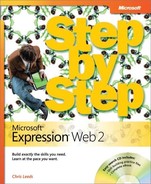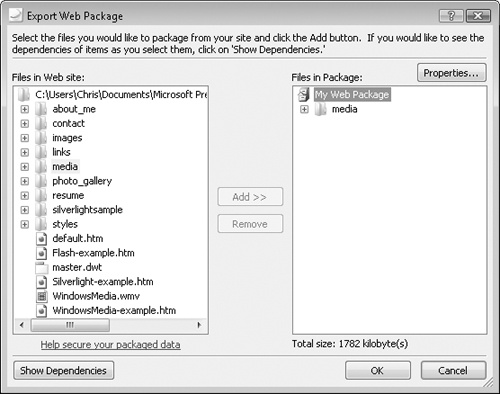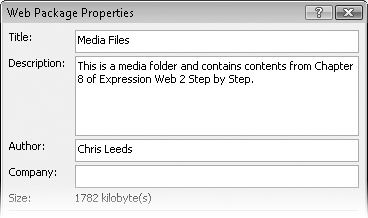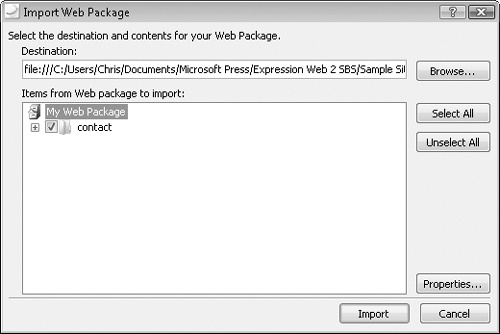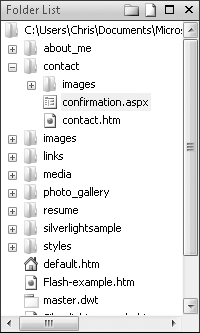If you’re an experienced site designer, you’ve probably amassed a large collection of files and scripts such as shopping carts or database applications that you tend to use in all or most sites that you create. If you’re very new to Web design, you will probably begin to develop this type of collection very soon.
With a Personal Web Package, you can export a collection of scripts or other assets from within a site; and you can save all of the data to a single file (an FWP file), which you can save on your local computer or distribute by any method you want, such as e-mail or a link on a Web site.
After a collection of files has been exported as an .fwp file, it can be imported very easily by any Expression Web 2 user.
Here’s a scenario: The media folder in the sample site is a project that you want to save to reuse in another site. You can export the media folder as a Personal Web Package.
In this exercise, you will export and import a Personal Web Package.
Note
USE the CH8 sample site you modified in the previous exercise.
OPEN the CH8 site if it isn’t already open.
On the File menu, point to Export, and then click Personal Web Package to open the Export Web Package dialog box.
The Export Web Package dialog box checks for file dependencies when you add a page to the export list. For instance, click media in the Files in Web site list, and then click Add. When Expression Web 2 asks if you would like to include the contents of the folder in your Web package, click Yes.
The media folder is copied to the Files In Package list. It is copied because the files within the media folder don’t depend on any files outside that folder.
In the Files in Web site list, click default.htm, and then click Add.
All of the files in the site are now copied to the Files In Package list. That’s because the default page is dependent on almost every file in the site: cascading style sheet files, images, the master.dwt file, even the pages that it links to.
In the Files in Package list, select all of the files and folders, and then click Remove to clear the export project. In the Files in Site list, click media, and then click Add.
Click Properties to open the Web Package Properties dialog box. Change the name from My Web Package to Media Files. Add a description, author, and company name if you want.
This information will be contained within the package. In the bottom of the dialog box, you can see a list of external dependencies, which are references to files outside the current site, such as pages that hyperlinks point to or absolute references to images or other files.
In the Export Web Package dialog box, click OK.
The File Save dialog box opens.
In the File Save dialog box, browse to a location where you want to save the exported Web package, and then click Save.
Web package exports can really bolster your long-term asset and workflow strategy. Imagine setting up your favorite shopping cart, a package of utility-type scripts you use, and a few other items in logical arrangements as Web packages. You’d be able to easily bring them into any project that is open in Expression Web 2 with only a few clicks.
Tip
You can use Web Package exports to cull files. If you’ve been working on a project for a while, the site probably has become loaded with revisions, old files, and all the other artifacts that a project tends to produce. If you want to pare the project down to the essential pieces—for instance, to send it to a customer or as a preparatory step before publishing to a server—you could select only the files you need to keep and let Expression Web 2 take care of adding the dependent files to your export list.
You can simply export the Web Package and send it off to someone else, or you can create an empty site and import it. Regardless of how you use the Web Package, it’s a fast way to isolate only the files you need and leave unnecessary files behind.
On the File menu, point to Import, and then click Personal Web Package to open the File Open dialog box. Browse to the DocumentsMicrosoft PressExpression Web 2 SBSFiles folder, click the CH8.fwp file, and then click Open.
The Import Web Package dialog box opens. In this dialog box, you can select or deselect files and folders and view the properties of the Web Package.
Click Import to import the contact folder and the files it contains to the root of your site.
In the security warning dialog box that opens, click Run to continue the process of importing the contents of this Web Package.
Click OK in the deployment complete message box to complete the process.
A file named confirmation.aspx now exists in your site contact folder. This folder and its contents will be used in the next exercise, in which you will work with forms.
Personal Web Packages make certain functionality, graphics, and other assets portable. In addition to the portability benefit, the export process can be helpful in enabling you to package only files you want to keep and to discard unnecessary files.
